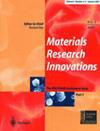Bi 2 O 3 nanoparticles: phytogenic synthesis, effect of calcination on physico-chemical characteristics and photocatalytic activity
Q2 Engineering
引用次数: 0
Abstract
ABSTRACTThe present work reported the bioinspired synthesis of Bi2O3 nanoparticles (NPs) using Ziziphus mauritiana leaves aqueous extract at four annealing temperatures (300, 400, 500, and 600C°) and examined annealing temperatures effect of on various physicochemical characteristics and photocatalytic activities of NPs. The XRD and Raman results reveal the existence of α and β polymorphs of Bi2O3 in all samples but with increase of calcination temperature the extent of α-phase, particle size, and crystallinity were increased while band gap value decreased. The BET results confirmed the mesoporous structure of all samples. Further, decolorization experiments conducted with crystal violet (CV) dye showed an observable effect of annealing temperature on the adsorption and photocatalytic efficacy of the prepared samples, and the utmost (99.88 %) removal of CV dye was computed with the Bi2O3 nanoparticles calcined at 300oC (B-300). The main active species involved in the photo-mineralization of dye was h+ followed by •OH..KEYWORDS: Bi2O3ziziphus mauritianacalcination temperaturephotocatalytic efficiencycrystal violet dye AcknowledgmentsThe authors are grateful to the University of Rajasthan, Jaipur, for providing infrastructural support. The technical assistance for this study was provided by MNIT, Jaipur Campus, and CAF, Manipal University, Jaipur.Disclosure statementThe authors declare that they do not have any conflict of interests among them.Supplementary materialSupplemental data for this article can be accessed online at https://doi.org/10.1080/14328917.2023.2258469二氧化钛纳米颗粒:植物合成、煅烧对其物理化学特性和光催化活性的影响
摘要本文报道了在300、400、500、600℃四种退火温度下生物合成Bi2O3纳米颗粒(NPs),并考察了退火温度对纳米颗粒理化性质和光催化活性的影响。XRD和Raman结果表明,样品中均存在Bi2O3的α和β多晶,但随着煅烧温度的升高,α相的范围、粒度和结晶度增大,带隙值减小。BET结果证实了所有样品的介孔结构。此外,用结晶紫(CV)染料进行脱色实验,发现退火温度对制备的样品的吸附和光催化效果有明显的影响,并计算出在300℃(B-300)下煅烧的Bi2O3纳米颗粒对CV染料的最大去除率(99.88%)。参与染料光矿化的活性物质主要是h+,其次是•OH。关键词:bi2o3、ziziphus、mauritia、煅烧温度、光催化效率、结晶紫染料。作者感谢斋浦尔拉贾斯坦大学的基础设施支持。本研究的技术支持由印度理工学院斋浦尔校区和印度理工学院斋浦尔分校CAF提供。声明作者声明他们之间不存在任何利益冲突。补充材料本文的补充数据可在https://doi.org/10.1080/14328917.2023.2258469上在线获取
本文章由计算机程序翻译,如有差异,请以英文原文为准。
求助全文
约1分钟内获得全文
求助全文
来源期刊

Materials Research Innovations
工程技术-材料科学:综合
CiteScore
5.20
自引率
0.00%
发文量
38
审稿时长
2.8 months
期刊介绍:
Materials Research Innovations covers all areas of materials research with a particular interest in synthesis, processing, and properties from the nanoscale to the microscale to the bulk. Coverage includes all classes of material – ceramics, metals, and polymers; semiconductors and other functional materials; organic and inorganic materials – alone or in combination as composites. Innovation in composition and processing to impart special properties to bulk materials and coatings, and for innovative applications in technology, represents a strong focus. The journal attempts to balance enduring themes of science and engineering with the innovation provided by such areas of research activity.
 求助内容:
求助内容: 应助结果提醒方式:
应助结果提醒方式:


